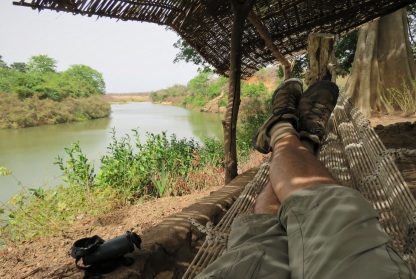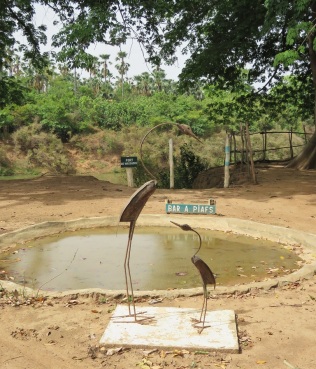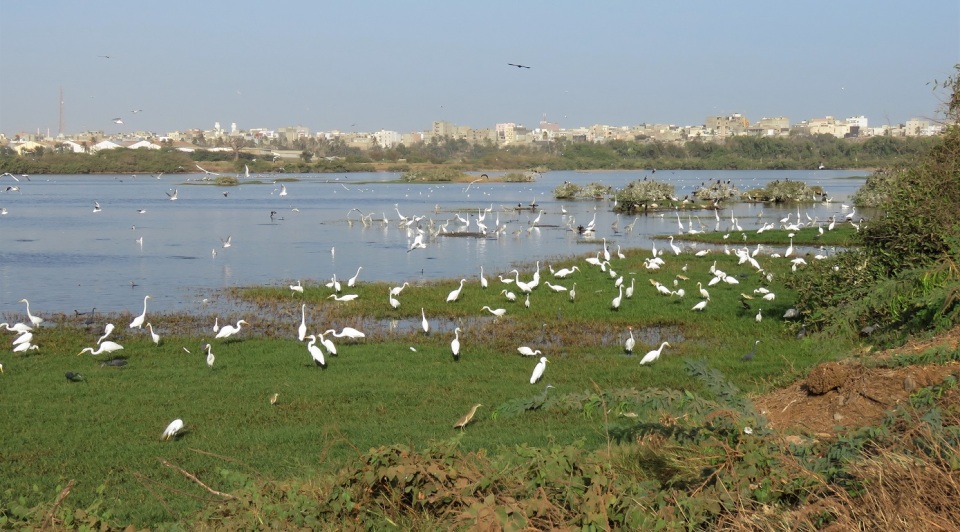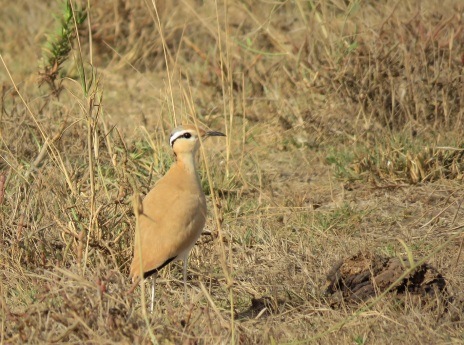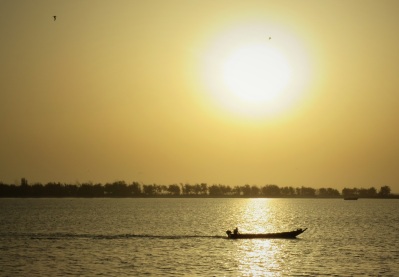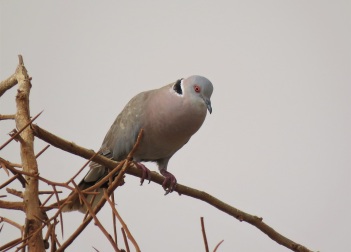Au revoir la Teranga
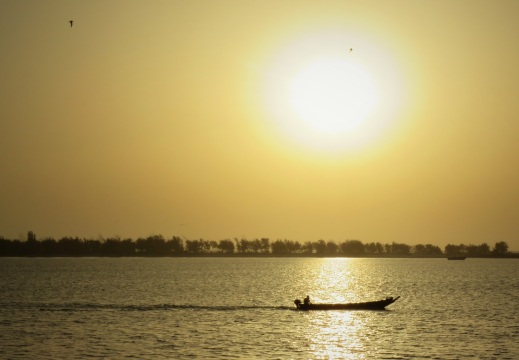
Our regular readers will have noticed that it’s been very quiet on this blog in recent months, so it’s about time I published an update here. There’s a simple reason for the lack of recent posts: after just over five years in Dakar, it was time to move on. Three weeks ago we landed in Laos where we will be based for the foreseeable future, marking the start of a new adventure here in Vientiane. And the end of a pretty amazing experience living in Senegal.
Moving on is of course bittersweet, as I will certainly miss the fabulous bird life that Senegal has to offer, yet at the same time I’m excited to discover the birds and culture of Laos. Even if we’re currently living in rather unsettling and unpredictable times, to say the least. Many of you will be reading this while confined at home, but being extremely busy with my work here I’ll need to keep it short… somehow writing this post is actually the one that I’ve struggled the most with so far – it’s been sitting in my drafts for about three weeks now.
Over the past five years I managed to visit all but one of the country’s regions – sadly I never made it to Matam! – and was lucky to see a good deal of its birds, 530 species to be precise, 527 of which I saw during 2015-2020. A few other numbers: some 52,500 records “collected”, four additions to the country list, about 1,040 sound recordings posted on xeno-canto, tons of poor quality bird photographs, countless happy hours in the field…
There are of course a few specials that I didn’t get to track down, such as Golden and Egyptian Nightjar, White-throated Francolin or Denham’s Bustard to name but a few, and I somehow managed to never visit Kousmar (pretty unbelievable right?) and the Niokolo-Kobo proper (I was happy enough exploring Wassadou on three occasions), but these are all good reasons to one day come back of course. That said, I’m not very optimistic about the state and future of Senegal’s environment, and while this is not the time to expand on this, there have been many frustrating, sad and upsetting moments when confronted on an almost daily basis with the ongoing destruction of natural habitats, with the ever-increasing pollution levels, and with the population’s general indifference and ignorance when it comes to nature and wildlife conservation.
Senegal certainly has treated us well and I feel privileged to have had the chance to explore the country these past few years. I tried to promote birding in Senegal and think I made some modest contributions to the “body of ornithological knowledge” both through this blog (149 posts!) and through a number of papers, 14 to be precise, something we’ll try to continue doing in coming months (years?). The absence of recent posts on SenegalWildlife is definitely not for a lack of ideas or material… just need to find the time to write up stuff, be it here in these pages or elsewhere.
Lots of good memories, of encounters with birds of course but also of places and people, too many to start listing here. Unexpected finds, and some unexpected birding settings.
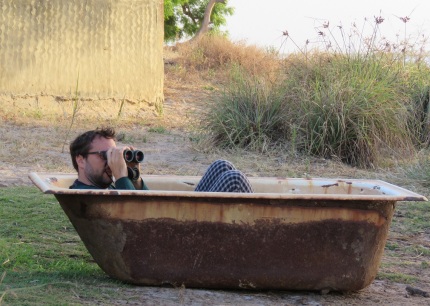
Birding the Saloum delta (yes that’s me in my pyjamas in a bath tub on the edge of a mud flat, one of those randomly surreal settings one may find oneself in… only in Senegal!) – Picture by Jane Piot
Despite the crazy busy few weeks leading up to our departure from Dakar, I was of course keen to go back out to some of my favourite spots: Popenguine, Technopole, Mbeubeusse, Lac Rose, and of course Le Calao for my daily dose of seawatching.
And as always there were some good birds to be seen here, some of which were quite unexpected. During my last visit at Technopole on the morning of our departure (8.3), a pair of Eurasian Teals was a nice find. My final ring reading here was of a French Eurasian Spoonbill ringed in the Camargue colony in 2016… with now +600 ring readings in my little database, there’s definitely enough material to write up another post on this topic. An immature Brown Booby on 21.2 and 5.3 at Ngor was pretty classic at this time of the year. Much less expected was a fine Cream-coloured Courser on the steppe near lac Rose on 20.2, apparently the first record for the Dakar region. It was loosely associating with a few Temminck’s Coursers, a classic species here, just like the handful of Greater Short-toed Larks that were present the same day. A few days earlier, a Temminck’s Stint at Mbeubeusse (16.2) was yet another scarce migrant to show up at this prime location for waders. And during our last visit to Popenguine (23.2) a Chestnut-crowned Sparrow-Weaver was a good record from this location, of a species that is rarely reported away from the south-east and that in fact I’d only seen once before in Senegal, near Kedougou.
Thanks to our followers and regular readers.
Take care, stay safe, flatten that curve.
Au revoir le pays de la Teranga, à la prochaine!
Yellow-throated Longclaw in Dakar – irregular visitor or an overlooked resident?

There’s a handful of bird species here in Dakar that remain rather enigmatic, and whose status and patterns of occurrence remain to be fully understood. One of these is the Yellow-throated Longclaw (Macronyx croceus), a member of the pipits and wagtails. Longclaws are a genus that is entirely restricted to Africa where eight different species are known, some of which have small or patchy distribution ranges. The Yellow-throated Longclaw is certainly the most widespread species, but here in Senegal we’re right at the edge of its range: while nowhere common, it’s probably quite widespread in Basse-Casamance (Ziguinchor, Oussouye, Cap Skirring/Diembering, Kafountine/Abene… even Sedhiou a bit further inland). There are just a handful of observations from north of the Gambia, where the species is apparently on the decline, at least in coastal areas where very few recent sightings it seems. The scant information that we have is mostly based on old records from the Dakar peninsula, more on these later. It’s clear though that this is a very little known species that at best is obviously scarce and localised, and while I certainly have it somewhere in the back of my mind when visiting lac Rose, I didn’t think I’d ever see it here.
Until yesterday morning, when I came across not one but two of these cool “sentinels” as they’re called in French: first one on the margins of the Mbeubeusse wetlands (99% dry now!), a bird flying over a reedbed and landing out of sight quite a distance away. A rather frustrating sighting but just decent enough to confirm the id: broad wings, medium-long tail with white corners, vivid yellow throat and breast with black markings on side of throat. I may have heard it singing shortly before I saw it but not sure as it called only once and Crested Larks can sound a bit similar!
The second bird was found barely an hour later at lac Rose, right at the Bonaba Café on the northern shores of the lake, and “performed” much better than the first! Upon arriving at this site, I could clearly hear it singing for several minutes on end; it even allowed me to get quite close so I could document this bird on camera (and on sound recorder: a sample of its simple yet rather melodious one-note song here.
These are the old records known from the Dakar area:
- August 1968 – “seen several times in coastal region 20 km east of Dakar” (M.P. Doutre; Morel & Morel) – this may well be near lac Malika or Mbeubeusse
- 9 April 1977 – 2 singing, Lac Rose (W. Nezadal on eBird)
- January 1984 – “Dakar” (Paul Géroudet in M&M)
- February 1990 – one seen “north of Dakar” within the Dakar atlas square, but this could be anywhere between Guediawaye and Kayar… (Sauvage & Rodwell 1998)
- 17 February 1991 – 1, Lac Malika (O. Benoist on eBird)
More recently, there’s an observation of no less than five birds on 18 Jan. 2011 at lac Rose seen during a tour organised by Richard Ottvall for the Swedish AviFauna group. Almost five years later, another mention from the same site, unfortunately without any further comments other than that it was on 20 November 2014 at lac Rose (near the southern edge, not far from Le Calao lodge), by J. Nicolau during a scouting visit for Birding Ecotours. The only other recent record north of the Gambia that I came across was of two birds in the Saloum delta (though where precisely?) on 8 January 2017 (J. Wehrmann on observation.org).
Could it be that there are just a few birds that are mostly escaping us – some relictual population from greener days when rains were plentiful here? It’s hard to believe though that if they were present year-round, that we haven’t come across them since we do visit Lac Rose and Mbeubeusse fairly regularly, in all seasons. Or are they present only certain years, and if so at what time of the year? The series of observations from the late sixties up to early nineties is certainly intriguing and would suggest that the species was fairly well established in the Niayes region, especially when one factors in the even lower observer pressure than currently. With records from January (2), February (2), April (1), June (the two in this report), August (1) and November (1) it seems that they can be expected pretty much at any time of the year. More investigations are needed of course and we’ll see if we can find out more in coming months.
Some other good birds from the weekend…
Also on the lake shore were a few Lesser Black-backed Gulls with a second summer Yellow-legged Gull in the mix, some 33 Audouin’s Gulls (i.e. far less than last year at the end of June), Little Terns at colony, a female Greater Painted Snipe (first time I see this species here) and a few other waders (nine Sanderling, 40+ Common Ringed Plovers. a few Greenshanks and Grey Plovers, one Redshank), as well as at least three Brown Babblers – my first in the Dakar region I believe (Goélands brun, leucophée, d’Audouin; Sternes naines, Rhynchée peinte, Sanderling, Grand Gravelot, Chevaliers aboyeur, Pluvier argenté, Gambette, Cratérope brun).
A brief walk and a quick scan of the steppe to the north-east revealed a few Singing Bush Larks and the usual loose flocks of Kittlitz’s Plovers (31 birds including at least 2 small chicks and an older juv.), though no Temminck’s Coursers were seen this time round. Also here was another Osprey and a few Blue-cheeked Bee-eaters, which were also heard around the lake (Alouette chanteuse, Gravelot pâtre, Balbuzard pêcheur, Guêpier de Perse).
At Mbeubeusse, apart from the Longclaw the surprise du jour was a fly-over pair of Spur-winged Geese (Oie-armée de Gambie), no doubt looking for fresh water…
Target of the day however was Black-winged Stilt – well, in addition to a few others such as the gull flock I wanted to check on – as I was keen on gathering more breeding data. More on this in a later post, but here’s already a picture of an adult with one of its chicks, from Mbeubeusse where there’s hardly any water left in the small pond close to the main road (= near the end of the Extension VDN). Just like last year, several families and nests were found at Lac Rose, and this morning at Technopole I managed to do a fairly extensive count of the number of families and nests. The breeding season is still in full swing and I hope that many of the birds that are still incubating will see their eggs hatch: with low water levels, predation by feral dogs, Pied Crows, Sacred Ibises etc. may be even more of a risk than usual. Overall it certainly seems that there are fewer nests and fewer grown chicks than last year – again, more on this later!
Not a target but always a pleasure to watch these highly underrated doves:
Other stuff of interest from this morning’s visit to Technopole – shortly after the first rain of the season (a very small shower only, but nevertheless: first rain since early October!) – were four Broad-billed Rollers which just like last year seem to favour the area to the NW of the main lake, again Diederik Cuckoo singing, the same Yellow-legged Gull as the previous day at Lac Rose, close to 1,500 Slender-billed Gulls including the first juveniles of the year, as well as the first Black-tailed Godwits of the “autumn”: these are birds that have just arrived back from western Europe, most likely failed breeders. (Rolle violet, Coucou didric, Goélands leucophée et railleur, Barge à queue noire)
Full list here.

Red-necked Falcon / Faucon chiquera
Note!
Visitors to Technopole should know that there is now a poste de contrôle (check point) near the entrance, just after the Sonatel building, manned by rangers from the DPN (National Park Service). This is the first tangible sign that the newly acquired protected status of the site is actually making a difference; hopefully their presence will help prevent illegal dumping and may give potential visitors more of a sense of security. Please do stop and explain that you’re there to watch birds (they will ask anyway, and if you don’t stop they’ll tell you off on the way out). Do note that entrance remains free to all, and that there’s no entrance fee.
AGPs again

Quick note to report Senegal’s 12th and 13th American Golden Plovers, a species that is now near-annual here but which always remains a good find.
We found the first of the season last weekend at lac Mbeubeusse (north of Keur Massar) which we visited early afternoon on our way back from a very enjoyable trip to Popenguine – more on that visit in an upcoming post. Both the date (3 November) and the location are rather typical for this wader: out of the 11 previous records, eight are from the Dakar region, and three were obtained between mid-October and mid-December. Paul had already seen a bird in the same location back in March 2013: needless to say that lac Mbeubeusse ought to be visited much more frequently than just a handful of times per year: pretty much every visit is bound to turn up something good. As always we can only speculate about the number of Nearctic vagrants that pass through Senegal every year or that end up spending the winter here…
After spotting what looked like a suspicious Pluvialis plover (= anything but a Grey Plover), based on the fairly contrasted plumage, seemingly long-bodied and long-legged appearance combined with a small-ish bill, we had to wait a while, gradually approaching the lake’s edge, before we could confirm that it was indeed a “Lesser” Golden Plover (= American or Pacific GP). The important primary projection with wing tips reaching well beyond the tail, bronzy rump and lower back, dark-capped head with distinctive pale supercilium and forehead, and most significantly at one point the bird stretched its wings upwards which allowed us to see the grey underwing. Everything else about the bird was pretty standard for a first-year American Golden Plover. Bingo!
To get a sense of the potential of lac Mbeubeusse for waders and other waterbirds, check out our eBird checklist: other good birds here included hundreds of Northern Shovelers and many Garganeys, Ruffs, Little Stints and Common Ringed Plovers, several Curlew Sandpipers and Dunlins, quite a few Audouin’s Gulls, a few terns including all three species of Chlidonias marsh terns, 124 Greater Flamingos, at least one Red-rumped Swallow, etc. etc. All this with Dakar’s giant rubbish tip as a backdrop, spewing black smoke and gradually covering the niaye in a thick layer of waste on its western edge… quite a sad contrast with all the bird life. And definitely not the most idyllic birding hotspot!
Number 13 was found by Mark Finn barely a week later, on Friday Nov. 9th, at one of the lagoons near Pointe Sarène, south of Mbour. As I happened to spend the weekend at nearby Nianing and was planning on visiting Sarène anyway, I went there the following day and easily located the bird, an adult moulting into winter plumage. Unlike the previous bird, it was actively feeding on the shores of a seasonal pond surrounded by pastures and fields, along with several other waders including Ruff, Redshank, Greenshank, Redshank. Wood Sandpiper, Green Sandpiper, Marsh Sandpiper, Turnstone, Common Sandpiper, and Common Snipe. This appears to be the first record along the Petite Côte south of Dakar, at a site that has great potential for shorebirds and other migrants: around Nianing, Sarène and Mbodiène are several seasonal lakes that fill up during the rains, as well as coastal saltwater (or brackish) lagoons as can be seen on the map below. The marker shows where the AGP was feeding on Saturday.
Despite being a bit distant I managed some decent record shots of the bird, but unfortunately my camera was stolen later in the weekend… so these pictures are lost forever to humanity. Not that I would have won any prizes with them. So no more blurred pictures from the field on this blog for a little while.
The Sarène bird looked pretty much like this one, just slightly less black on the chest:
Anyway, as I think we’ve already mentioned in the past, “AGP” is the most frequent Nearctic wader in Senegal and more generally in West Africa, followed by Buff-breasted Sandpiper (nine Senegalese records so far) and Lesser Yellowlegs (eight). See this post for a list of the first eight known AGP records for Senegal. Since then (spring 2017), the following sightings are to be added:
- April-May 2017: an adult and two 2nd c.y. birds from 17.4 – 1.5 at least, with a fourth bird (= technically an additional record) up to 21.5., at Technopole (BP, Theo Peters, Wim Mullié, Miguel Lecoq, Ross Wanless, Justine Dosso)
- 8 April 2018: an adult or 2nd c.y. at Technopole (BP) – photos above and more info here.
- 3 November 2018: one 1st c.y. at lac Mbeubeusse, Dakar (BP, Gabriel Caucanas, Miguel Lecoq, Ross Wanless)
- 9-10 November 2018: one ad. at Sarène, Thiès region (M. Finn et al., BP)
Out of these 12 records, eight are from Dakar (mostly Technopole of course!), just one from the north – the first country record, in 1979 – and two are from Basse-Casamance where the species may well winter, at least occasionally. And six of these records are from just the past four years: one in 2015, four birds in 2017, and now already three birds this year. American Golden Plovers tend to mainly show up in spring (April-May) and in autumn (Oct.-Nov.) as shown in this little chart below; it’s also in spring that they linger the longest: in spring 2017, Technopole saw a continued presence during five weeks, involving at least four different birds. Note that birds that stayed for several days across two months are counted in both months.

American Golden Plover records
A few more hazy pictures from the Mbeubeusse bird:

